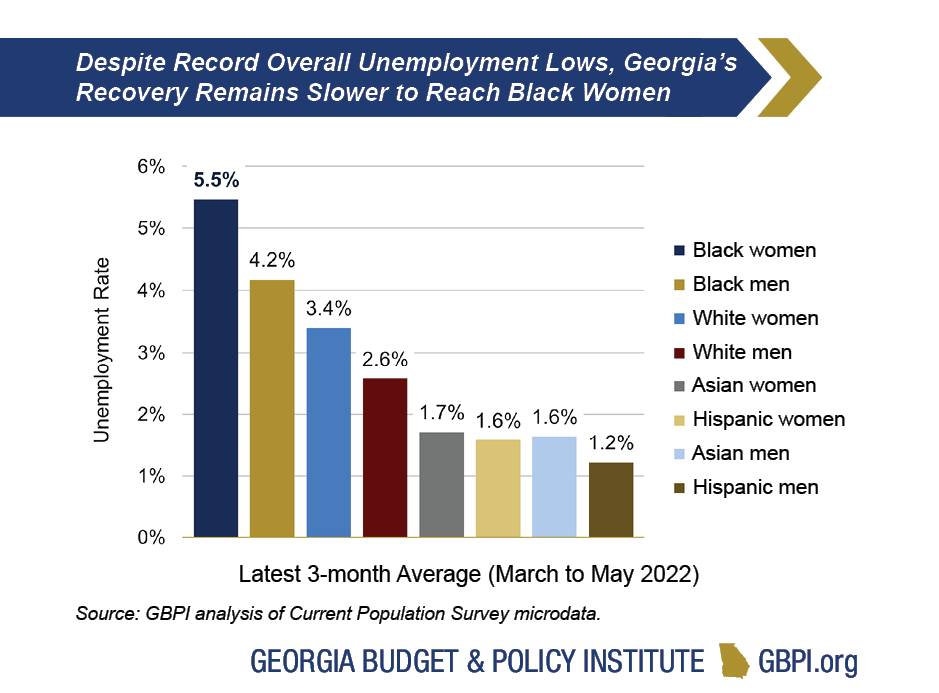This section is co-authored by Economic Justice Senior Policy Analyst Ife Finch Floyd and Worker Justice and Criminal Legal Systems Policy Analyst Ray Khalfani.
Georgia’s 2023 Human Services Budget
State lawmakers approved $920 million for the Department of Human Services (DHS). The DHS budget restores cuts from previous years and includes more state resources than in FY 2020, the last pre-pandemic budget. About $38 million in the DHS budget is attributed to a $5,000 increase in the cost-of-living adjustment (COLA) for full-time employees. The Child Care Services budget also restores cuts, but still falls just shy of where it was in FY 2020.
Foster care and child welfare services together are 63 percent of the DHS budget. Low-income family support programs and services make up the next largest share (15 percent of the total DHS budget). This includes eligibility determinations for public benefits, refugee assistance and out-of-school care.

Budget for Child Welfare and Foster Care Services Makes Key Improvements
The FY 2023 budget includes $356 million for foster care and adoptions and $228 million for child welfare services. Combined, this is 10 percent more than the FY 2022 budget for these services and 9 percent more than the FY 2020 budget.
In addition to the COLA, Georgia lawmakers approved several improvements to foster care and child welfare services.
- Additional supports for foster care parents and providers to address the high costs of caring for children
- $28 million for a 10 percent increase in the provider rate for foster parents and group home providers.
- $3 million to increase funds for the annual foster care clothing allowance by $275 per child.
- Nearly $3 million for pilots and programming for children in or at risk of foster care and children with autism in the child welfare system
- $1.5 million to pilot new foster care prevention strategies and provide additional supports to foster care children.
- $452,000 for an autism diagnosis pilot for foster care children in Region 12.
- $1 million for autism respite care to provide short-term help for caregivers in caring for a child with unique needs.
- Additional salary increases for Special Assistance Attorneys General (SAAGs)
- $6.3 million to increase the hourly earnings by case for SAAGs, which represent the state in juvenile court proceedings, and SAAG paralegals. This increase is to help retain SAAGs and paralegals and to address the case backlogs.
The COLA Alone Won’t Fix the Staffing Shortage
While the COLA is significant, it will not make up for all the staffing shortages. Robust workforce investments will be critical to stop the decline. For example, the FY 2023 budget does not add back the positions defunded in previous budget cycles. DHS saw a decline in staffing from 9,762 in FY 2019 to 9,165 in FY 2021, a 600-worker difference. There are indicators that the workforce shortage continues to get worse in 2022. DHS Commissioner Candice Broce said in a public interview in March 2022 that staffing levels at DHS were around 8,300.
Low staffing levels among frontline eligibility staff may be of great concern in the next year. During the pandemic, the federal government granted temporary flexibilities that allowed more people experiencing financial hardship to access and maintain public benefits while mitigating some of the administrative burdens for eligibility staff. Those flexibilities may end later this year and eligibility staff will have to re-determine Medicaid and SNAP eligibility for millions of Georgians. Without robust investments to increase the eligibility workforce, staff will have limited capacity to handle the unprecedented influx of re-determinations, which could lead to Georgians experiencing harmful temporary losses in benefits. There could also be longer processing benefits for current clients or new applicants. If eligibility determinations take too long, the state could be subject to legal action like it was in the mid-2010s.
Furthermore, there could be disproportional impact on Black recipients who make up a significant proportion of SNAP, TANF and Medicaid recipients. Longer wait times could exacerbate the nutritional and financial hardship and limited health care access Black families are already more likely to experience than white families.
Georgia’s 2023 Department of Labor Budget
The $6.1 million FY 2023 budget for the Georgia Department of Labor (DOL) decreases spending from FY 2022 levels by $6.8 million, a decrease driven by the upcoming transfer of workforce development program funds to the state’s Technical College System, and staffing capacity cuts that remain in place since FY 2020 spending was amended. Remaining Department spending sits nearly $100,000 below FY 2020 levels, despite the COVID-19 economic downturn’s magnification of DOL’s long-term state investment needs.
The bulk of FY 2023 state funding for the DOL will go to two divisions: Department Administration, which provides administrative support to each program division within DOL, and Unemployment Insurance (UI), which collects UI taxes from employers in the state and distributes unemployment benefits to eligible claimants. While each DOL division administers programs through a significant portion of federal funding, which will cover 87 percent of total FY 2023 DOL spending, state allocations provide dedicated funding sources to maintain the efficiency of Georgia’s DOL through the ebbs and flows of federal funding.
To stabilize families and the larger economy, DOL processed more than 5.2 million claims and dispersed billions in benefits to involuntarily jobless Georgians following the COVID-19 pandemic economic shockwave, despite claimant access and claims processing challenges. State lawmakers recently allocated some of the first tranche of federal ARP relief funds towards several workforce training initiatives but have yet to utilize any ARP funding to modernize Georgia’s UI system to be more accessible and resilient in protecting dislocated workers, and Georgia’s broader economy, in future downturns.
Georgia’s Pandemic Recovery: Trends in Employment, Unemployment and Underemployment
Year three of the COVID-19 pandemic recovery has been mixed. Georgia workers have experienced steady rises in employment in certain private industries–including Trade; Transportation and Utilities; Financial Activities and Professional and Business Services–which have filled more jobs than they did in pre-pandemic February 2020. Other private industries like Construction as well as Leisure and Hospitality, have yet to fill all of the jobs lost in early 2020, and experienced declining shares of Black and Hispanic women over the last year, which may correspond with their rising employment shares in Trade; Transportation and Utilities; Financial Activities as well as Professional and Business Services industries over nearly the same period. Georgia’s state-level public sector employment remains 8 percent below its February 2020 payroll employment levels. Furthermore, unemployment and underemployment disparities persist across race, ethnicity and gender, and gaps among Black and white workers in Georgia remain nearly two to one.









